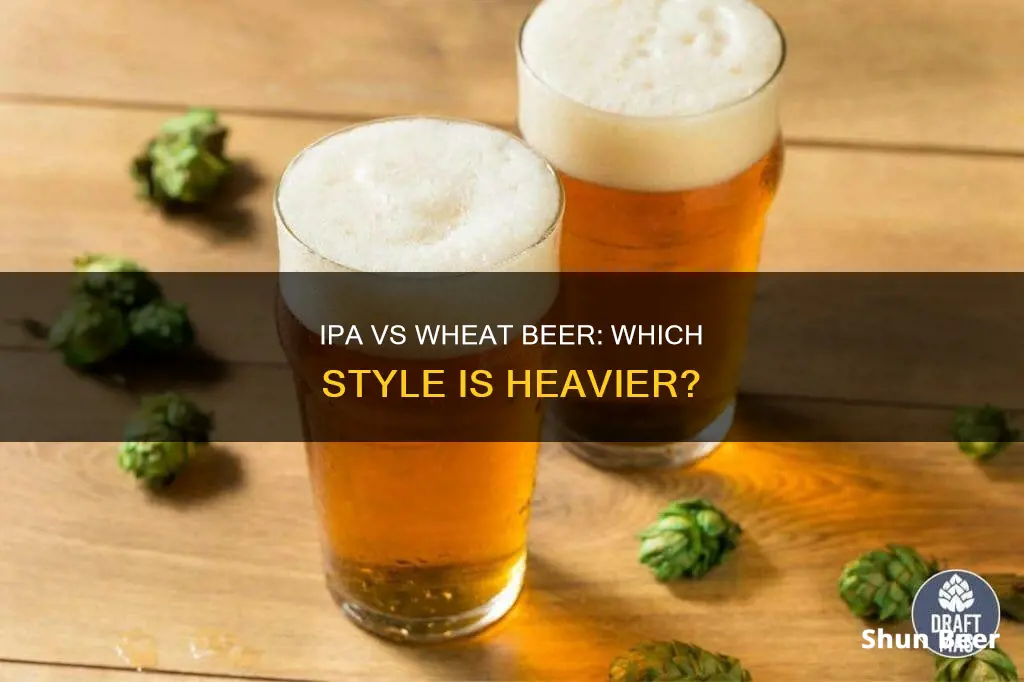
India Pale Ales (IPAs) and wheat beers are two distinct styles of beer with their own unique characteristics. IPAs are known for their strong hoppy flavour, which can range from piney to citrusy, while wheat beers tend to have a lighter colour and alcohol content, making them a perfect summer drink. So, which one is heavier? IPAs tend to have a higher alcohol content and can be more bitter due to the higher concentration of hops. Wheat beers, on the other hand, are usually lighter in colour and alcohol level, and are known for their crisp and tangy flavours. However, it's important to note that there are many different varieties of each style, and the specific gravity and alcohol by volume (ABV) can vary greatly, so it's difficult to make a generalisation about which is heavier. The best way to find out is to try them for yourself!
| Characteristics | Values |
|---|---|
| ABV | IPAs tend to have a higher ABV than wheat beers. |
| Taste | IPAs are known for their strong, hoppy flavour, while wheat beers are described as crisp, drinkable, and bready. |
| Appearance | Wheat beers tend to have a hazy appearance. |
What You'll Learn

IPAs have higher ABV and are hoppier than wheat beers
India Pale Ales (IPAs) are often stronger than wheat beers. IPAs tend to have a higher alcohol content, usually in the 5-7% ABV range, while wheat beers are perfect for kicking back during the summer and are often combined with fruit.
IPAs are known for their bold, bitter, and strong flavours, which come from hops and herbal, citrus, or fruity flavours. The final product depends on the variety of hops used. Some IPAs can taste like pure citrus, while others are strong and bitter. Wheat beers, on the other hand, tend to have a light colour and alcohol level. They rely on wheat for the malt ingredient, which gives them a light, tangy, and funky flavour.
While not all IPAs contain wheat, some sub-styles do. The New England-style IPA typically uses about 50% wheat in the grain bill, and other sub-styles that contain wheat are White and Black, and sometimes English and Red IPAs. However, American and West Coast IPAs are not made with wheat to maintain their crisp, clean, and clear taste and mouthfeel.
So, when it comes to heaviness, IPAs tend to be heavier than wheat beers due to their higher ABV and stronger flavours. However, wheat beers can also vary in their alcohol content and flavour profile, so the heaviness can depend on the specific style and ingredients used.
Shandy and Wheat Beer: What's the Connection?
You may want to see also

Wheat beers are perfect for summer
Wheat beers are typically made with a high proportion of wheat, which gives them a light colour and alcohol level. They are highly carbonated and can be spiced with coriander, orange peel, lemon peel, and other herbs and spices. The high amount of protein in wheat, as well as oats, contributes to a signature cloudiness. Wheat beers are perfect for those who want something easy to drink and can be a gateway into craft beer for those who usually drink wine and spirits.
Wheat beers have a long history, with the first likely brewed by Sumerians 6,000 years ago, followed by the ancient Egyptians. In the 12th or 13th century, wheat beers started to be made in Bohemia (modern-day Czech Republic), and these styles later moved to modern-day Germany through Bavaria in the 1500s. Today, wheat beers are one of the most iconic and popular beer styles in the German region of Bavaria, where they are called weissbier ("white beer"). In the rest of the country, they are called hefeweizens ("yeast wheat"), and are typically unfiltered wheat beers that get their haziness and most of their flavour from the yeast.
Wheat beers are a great choice for summer drinking, offering a satisfying and refreshing alternative to pilsners, lagers, and IPAs. So, if you're looking for a perfect summer drink, be sure to give wheat beers a try!
Wheat Beer: Healthy Choice or Just Hype?
You may want to see also

Wheat beers have a light colour and low alcohol content
Wheat beers are known for their light colour and low alcohol content. Typically, wheat beers are light in colour, ranging from pale gold to straw-like. They are often described as cloudy or hazy in appearance, due to the presence of wheat proteins and yeast. This cloudiness is particularly notable in unfiltered wheat beers, such as the Hefeweizen style.
The light colour of wheat beers is a result of the brewing process. Wheat beers are typically top-fermented ales, and the type of yeast used can contribute to their light colour. For example, the yeast used in Hefeweizen beers produces a cloudy appearance and a light, golden colour.
In terms of alcohol content, wheat beers are generally considered low to medium in alcohol content. Some varieties, such as Berliner Weisse, have very low alcohol levels, typically ranging from 2.5% to 4% ABV. Other wheat beers, such as Weizenbock, have a higher alcohol content compared to their lighter cousins. However, even the stronger varieties of wheat beer tend to have lower alcohol levels compared to other beer styles like IPAs.
The low to moderate alcohol content in wheat beers makes them highly refreshing and easy to drink. They are often described as having a light, silky, or smooth texture, with minimal bitterness and a slight malty sweetness. The low bitterness is due to the low levels of hops used in brewing, and the sweetness comes from the malted wheat.
The combination of light colour, low alcohol content, and smooth flavour profile makes wheat beers an excellent choice for summer drinking. They pair well with a variety of dishes, including light salads, seafood, and fruit-based desserts.
Asahi Beer: Wheat-Free or Not?
You may want to see also

IPAs are more popular than wheat beers
India Pale Ales (IPAs) are more popular than wheat beers. This popularity is driven by cultural factors, the relative ease of brewing IPAs, and the distinctive taste of IPAs.
IPAs are a diverse category of beers with a range of styles, including West Coast, British, and New England IPAs. They are characterised by their use of hops and herbal, citrus, or fruity flavours. IPAs can be bitter and contain high alcohol levels, although the specific flavour profile depends on the variety of hops used. For example, New England IPAs are known for their fruity flavour and low bitterness, while British IPAs are maltier and more bitter.
IPAs are often a beer drinker's first introduction to craft beer. The North American IPA, in particular, is very representative of the craft beer movement. IPAs are also relatively easy to brew compared to other beers. Ales, including IPAs, are fermented at warmer temperatures, and the yeast settles at the top of the beer. This is in contrast to lagers, which require refrigerated temperature control during fermentation, making them more expensive and time-consuming to produce.
The distinctive taste of IPAs is another factor contributing to their popularity. IPAs offer a range of bold and complex flavours that are very different from the mass-produced lagers that dominated the American beer market for many years. IPAs tend to be strong, full-bodied, and rich in flavour and aroma. They can also be high in alcohol content, which some consumers prefer.
While wheat beers have their fans, IPAs are more popular among beer drinkers. This popularity is driven by cultural factors, the relative ease of brewing IPAs, and the unique and varied flavours that IPAs offer.
Coors Beer: Wheat-Free Refreshment or Not?
You may want to see also

Wheat beers have a distinctive smell
The fermentation process plays a role in the scent of wheat beer as well. Wild yeast, for example, can impart a sulfur smell during brewing, producing hydrogen sulfide that is later neutralized by the alcohol formed from sugar. Additionally, the presence of wild bacteria, such as Lactobacillus, Pediococcus, and Brettanomyces, can lead to tart, fruity, peppery, zesty, and spicy aromas in wheat beers.
The combination of wheat, yeast, and fermentation processes results in a complex and distinctive smell that sets wheat beers apart from other varieties. This unique aroma enhances the overall drinking experience, making wheat beers a popular choice for those seeking a refreshing and flavourful beverage, especially during the summer months.
While the scent of wheat beer is often described as bready and citrusy, it's important to note that the specific yeast and fermentation techniques used by different breweries can lead to variations in the aroma. Some wheat beers may exhibit stronger sulfuric notes, while others might showcase a delicate balance of fruity and spicy aromas.
Furthermore, the addition of herbs and spices in wheat beer recipes can further enhance their aroma. Historically, brewers used a mixture of herbs called "gruit," which included chamomile, rosemary, and yarrow, to counteract the sweetness of the beer. Today, hops are commonly used to add bitterness, contributing an earthy, piney, and citrusy scent to wheat beers. Thus, the distinctive smell of wheat beers is a result of a complex interplay between the grain, yeast, fermentation, and additional ingredients, creating a sensory experience that has garnered a dedicated following among beer enthusiasts.
Porter Beer and Wheat: What's the Connection?
You may want to see also
Frequently asked questions
IPA stands for India Pale Ale. It is a beer with a strong hoppy flavor.
Wheat beer is a beer that relies on wheat for the malt ingredient, giving it a light color and alcohol level. Wheat beers are perfect for kicking back during the summer and for combining with fruit, like a slice of lemon or orange.
Ales, the broader category under which IPAs fall, tend to be heavier, darker, and more alcoholic than lagers. Wheat beers, on the other hand, are often lighter and more suitable for summer. Therefore, it can be said that IPAs are generally heavier than wheat beers.
IPAs are known for their strong hoppy flavor, which can make them quite bitter. Wheat beers, on the other hand, are described as crisp, drinkable, and bready. Therefore, IPAs are likely to be more bitter than wheat beers.







